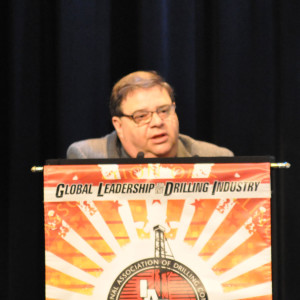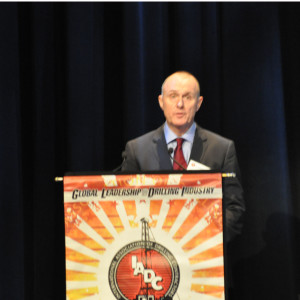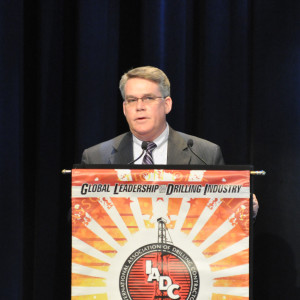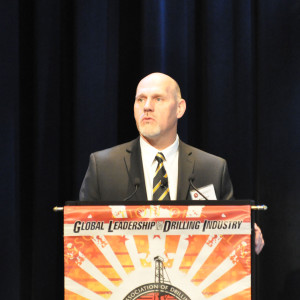Shale gas panel: Industry must engage, educate public to win trust
By Joanne Liou, associate editor

In the discussion of the environmental impact of shale gas development, the word “impact” has become more of a reference to the associated public policy issues, Alby Modiano, president of the US Oil & Gas Association, explained. There is a “fundamental shift in how energy is being produced and consumed to impact both domestic policy and our politics, and foreign policy and foreign politics,” Mr Modiano said in his keynote address and introduction to a panel session at the 2013 IADC Environmental Conference in New York City on 9 April. “The shift is going to affect our environmental policy as it comes with new public evaluation of the risks,” he said, noting the proximity of shale developments to centers of population.
Mr Modiano was joined on the panel by Paul Beat, director, Control Risks; David McBride, vice president – environment, health & safety, Anadarko Petroleum; Ed Ireland, executive director, Barnett Shale Energy Education Council; and Matt Blauch, director of product development, Nabors Completion & Production Services. Together the experts shared insights into lessons learned in hydraulic fracturing, as well as public education. Paul Breaux, IADC director onshore HSE, moderated the session.
The current shale boom in the US is dependent on two elements: tax policy and perception of environmental impacts, Mr Modiano stated. “Perception is absolutely critical. How do people make choices in what they believe? People in these city councils, controlling local ordinances – it’s what they believe that is most important to us. Even the smartest people can be duped.”
In the public arena, a myriad of information continues to circulate about the impacts, risks, fears and facts around shale gas exploration and production. The challenge is to discern the truths under such a bombardment of information. “When you worry about something, you’re probably pretty gullible,” Mr Modiano said, “and when you’re told to worry about something, then a different psychological process steps in, and there are many who worry about the impacts of shale gas exploration.” People take cues from other people, and beliefs are often shaped by whom people know, rather than what people know. “Our ability to acquire knowledge about truth and impacts is linked to our ability to figure out whom to trust about what,” he added. “By nature, humans are not skilled in assessing risks and knowing what to fear.”

Industry faces an uphill battle to gain public trust of shale development and was essentially caught off-guard by the “sophistication, speed and influence of the anti-fracking movement and perhaps failed to appreciate the social and political risks associated with intensive fracking development,” Mr Beat said. He believes governments, industry and investors all need a better understanding of that movement’s structure and methods.
The agendas of anti-fracking groups vary according to local priorities, but they typically share four “wants”:
1. A better deal for consultation and more direct and sustainable economic benefits;
2. Further study of environmental, economic and health impacts;
3. Moratoriums to completely prohibit development; and
4. Tighter regulation for the environment and more conscientious development.
On the public policy front, Mr Beat believes that industry has changed its tactic, acknowledging the level of activism and genuine grievances to address them. “It’s important to engage early with communities,” he said. “We’ve seen the result in some states where there is still a ban on fracking because of perhaps a lack of engagement with local communities in the early stages of fracking, and this process is repeating itself in countries around the world. There hasn’t been a huge amount of engagement. That is something industry is acutely aware of now.”

Mr McBride of Anadarko shared a similar sentiment toward early engagement but added transparency to the discussion. “Don’t just solve the problem for them and tell them what a great job you did, but engage them early, talk to them, recognize the issues, recognize the requests, recognizing that perception may indeed be what’s driving the issue. But recognize it upfront and be transparent about how you develop solutions.” By responding to questions from regulators, NGOs and the public, industry is collectively bringing greater awareness of the methods it uses to protect the environment and people.
On the regulatory side, industry maintains that states should oversee their own oil and gas regulations. “They have the best handle on local geology, local economy,” Mr McBride explained. “When we bring a national view toward regulation of this industry, especially around environmental issues, you get the one-size-fits-all answer.” Regionally, industry has established various forums to share HSE practices. “These are non-competitive things. These are things we all agree we should be able to do and implement – finding ways to share information is important and up to industry to do that.”

The Barnett Shale Energy Education Council (BSEEC) is one example of industry’s proactive efforts to reach out to the public with facts. The BSEEC was established just as drilling rigs were starting to move into Fort Worth in 2005 and 2006. With more than 18,000 wells already drilled in the Barnett Shale, the region boasts what it believes to be an excellent track record on environmental impacts, Mr Ireland said, and serves as a role model for other markets. “It’s a testament to the technology being used and the same technology being exported and used all over the US.”
The Dallas-Fort Worth and Barnett Shale area also has the most studied air in the country, Mr Ireland stated. The Texas Commission on Environmental Quality (TCEQ) installed 10 continuous air monitors and has collected more than 250,000 air samples over the past decade; more than 11 million tests of those samples have been performed. No test sample has ever come close to a health risk level, according to the TCEQ.
Due to drought conditions, water usage is an important issue in Texas. According to estimates by the Tarrant Regional Water District, approximately 0.5% to 1% of total water sales volume goes to drilling and fracturing in the region. “When people hear 5 million gallons are used to fracture a well, that may seem like a lot of water, but in the scheme of things, it is not,” Mr Ireland said.

Another hot spot in the US is the Marcellus Shale, and “a lot of the issues we’re dealing with today stem from the migration of hydraulic fracturing to the Marcellus Shale,” Mr Blauch of Nabors Completion & Production Services said. When activity started to ramp up from 2005 to 2008, “the move into the Marcellus raised a lot of public awareness, in which the industry was cast in the media’s negative light based on fear and questions. “(Hydraulic fracturing) is a foreign concept to most of the folks,” Mr Blauch stated. Unfortunately media reaction was focused on the negative side, and perception translates into action, he added.
The concept of total disclosure of fracturing fluid composition started as a voluntary process within the industry, an attempt to educate the public. “It was a great idea, but it did not achieve its desired goal. In fact, it resulted in many of the states adopting the process of chemical disclosure and writing those into law.” One of the biggest challenges in disclosure revolves around trade secrets. The process to disclose chemicals used in fracturing fluids is still in development and not well defined, he said. “The basic system is in place, but there are still a lot of moving parts that need to be resolved.”




